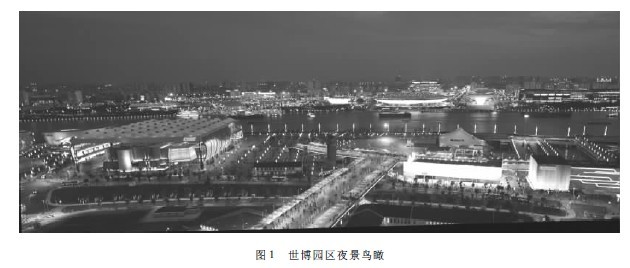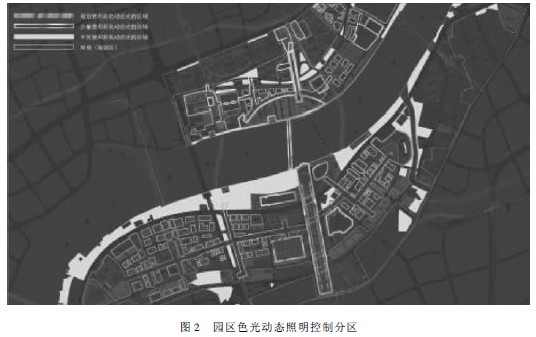China's 2010 Shanghai World Expo is the first registered and comprehensive World Expo hosted by developing countries in 159 years. The site of the park is located in the Binjiang area between the Nanpu Bridge and the Lupu Bridge. It is an important urban block for the transformation of the old city in the central city of Shanghai, the functional transformation of the two sides of the Pujiang River, environmental improvement and urban spatial development strategy. The two parks of Pudong and Puxi, which are separated by Pujiang Nature, are mainly built in new venues, while the latter are mainly based on historical preservation. The Shanghai Tongji Urban Planning and Design Institute was commissioned by the Shanghai World Expo Coordination Bureau to carry out the preparation of the night lighting plan for the 2010 Shanghai World Expo. As one of the special plans, the plan is guided by the theme of “Better City, Better Lifeâ€, with particular emphasis on the operability, guiding significance and control of the plan itself. As a national event, the special lighting plan has similarities with general urban lighting planning or regional lighting planning, but it also has its own unique approach in planning strategy. Highlight the characteristics of the World Expo, respect the overall planning of the World Expo, consider the changes in participating countries and locations, global energy shortages and environmental damage, explore the future of urban lighting innovation and sustainable development, with the core value of "harmony between man and nature" The goal of “sustainable development†has become an important criterion for measuring the value of the night illumination of the Expo, and it has become the task and challenge of the plan.
1 Expo and urban lighting
The World Expo has always been an important window for countries around the world to demonstrate their technological strength, cultural image and aesthetics. The World Expo is also regarded as the greatest event for human technological innovation. The development of artificial electric light sources is to benefit all mankind through the World Expo. The invention of the electric motor at the 1873 Vienna World Expo, the incandescent light bulb of Edison at the 1878 Paris World Expo, the first practical fluorescent lamp at the 1939 New York World Expo, and so on. The 2010 Shanghai World Expo coincides with the new wave of lighting technology revolution – solid state lighting. Through the integration and application of LED lighting technology, visitors can directly understand how to use the lighting technology and lighting art to interpret the theme of “Better City, Better Lifeâ€, and learn more about human science and technology. Direct promotion in various fields such as culture, art, and education.
The special plan for nightscape lighting for the Expo site can be traced back to the 1915 Pacific World Expo in Panama, and General Electric (GE) is responsible for the lighting of the entire Expo site. Their night scene design made this World Expo, so that the wonderful World Expo will continue after sunset. The night lighting planning of the last 2005 Aichi Expo in Japan was carried out by senior lighting designer Ishii Shiko. The night scene of the park is designed to convey the traditional Japanese light culture through modern lighting technology, emphasizing green lighting, energy saving and environmental protection, and symbiosis with nature. Planning concept. The overall planning of night lighting for the 2010 Shanghai World Expo Park was undertaken by Tongji University. The design team has been involved in the World Expo since 2006. The night lighting planning work of the Expo site is based on a series of pre-exposure research results of the World Expo. Through the analysis and research on the nighttime functional positioning of the Expo Park, the planning principles for the night lighting of the Expo Park are proposed (Figure 1). The plan focuses on the ways and means to achieve high efficiency and energy saving in the landscape light environment of the Expo site, the principles and methods of landscape art lighting that reflect the characteristics of the Shanghai World Expo, and the relevant design standards and management guidelines for the development of the light environment in the Expo site.

2 Shanghai World Expo Park night lighting master plan
The overall planning work of the night scene lighting of the Shanghai World Expo Park is based on a series of early-stage World Expo scientific research achievements. Through the analysis and research on the nighttime functional positioning of the Expo Park, the planning principles for the night lighting of the Expo Park are proposed. The plan focuses on the ways and means to achieve high efficiency and energy saving in the landscape light environment of the Expo site, the principles and methods of landscape art lighting that reflect the characteristics of the Shanghai World Expo, and the relevant design standards and management guidelines for the development of the light environment in the Expo site. The planning completed the night lighting subdivision of the Expo Park and the lighting grading of the stadium buildings, the color temperature of the Expo Park and the dynamic lighting control of the chromatic light. In order to better guide the night lighting design of Shanghai World Expo Park, in addition to completing the overall lighting planning of the Expo site, it also formed the application of lighting innovation technology in the Expo Park, the application of high-efficiency energy-saving lighting technology, road system lighting, night lighting of stadium buildings, public space. Eight sub-projects and guidelines for lighting, green space lighting, signage system lighting, and urban best practice area lighting are used to guide the development of the night lighting design phase, the project bidding phase and the deepening phase of the Shanghai World Expo Park.
In order to build an efficient and energy-saving night illumination system for the park, the relationship between the division of the night illumination of the park, the relationship between functional lighting and landscape lighting, the theme interpretation of the venue and the image of the night scene, the application of technology and innovation concepts, the control of visual comfort and light pollution, the opening and closing ceremonies of the Expo, The lighting mode and grading of the meeting after the meeting will be divided into two parts: the overall plan and the sub-program.
2. 1 Master plan
The overall plan mainly includes brightness grading control planning, color light dynamic lighting control zoning planning and illumination color temperature control zoning planning.
2. 1. 1 Park building lighting brightness classification control plan
At the beginning of the planning, the planning team conducted extensive urban environmental brightness surveys in several urban centers in Shanghai. Based on the analysis and evaluation of the current urban environmental brightness level in Shanghai, according to the characteristics of Shanghai cities, refer to relevant domestic and foreign norms and guidelines, and fully consider the landscape composition and visual needs of the Expo site, and propose different blocks in the park. The brightness control range of night illumination.

It is expected that after the completion of the construction project in the entire Expo Park, the existing sky brightness will be greatly affected (the brightness will be greatly improved), so the background brightness outside the park is estimated to be a “bright†background environment. However, due to the consideration of “Harmonious World Expo and Ecological Expoâ€, in addition to the key landmark buildings, the rest of the buildings will be designed in the Expo. In each pavilion and in different areas, the brightness is reduced in order of importance. After the Expo, the brightness of the highlighted area design will be appropriately reduced. The overall plan is divided into five areas.
2. 1. 2 Park color light dynamic lighting control zoning planning
The campus dynamic color lighting control zoning plan is mainly used to regulate the use of colored light and dynamic lighting, to avoid light pollution, and to control uncomfortable glare. Temporary lights such as performance lights are not covered here. The park is divided into four control areas. That is, (1) planning areas that use colored dynamic light, including the Expo Axis, the Axis Building (Expo Cultural Center, Theme Pavilion, etc.); (2) A small number of areas using colored dynamic light, including active green spaces, distribution squares, and elevated walkways; (3) Areas where color dynamic light is not suitable include the riverside landscape green space and the green space outside the stadium area. The peripheral green space is close to the residential area, and color dynamic light should not be used. In addition, considering the prominent visual effect of the China Pavilion “China Redâ€, color dynamic light should not be used; (4) Others mainly refer to self-built pavilions and rental halls, which can be adopted. Color light illumination, and dynamic change control of colored light, depending on the situation of each museum.
2. 1. 3 Park color temperature control zoning planning
The color temperature control zoning planning of the park is mainly based on the different functional divisions of the park and the light color control planning. The World Expo will span the hottest season in Shanghai, so you should consider the appropriate increase in color temperature when planning for light color, and also need to consider the use after the Expo. The park is divided into five types of control areas.
2. 2 sub-program
On the basis of the overall lighting planning, the planning team also carried out sub-planning design according to the composition of the night landscape of the park, in order to guide the construction of the night lighting of the park more specifically.
2. 2. 1 Park Building Night Lighting Planning
It is planned to divide the night lighting of the buildings in the park into three categories: “need to be night lightingâ€, “suitable for night lighting†and “not suitable for night lightingâ€. Among them, “the night lighting must be carried out†includes “emphasis lighting†and “appropriate lightingâ€.
The “key lighting†buildings include the China Pavilion, the Theme Pavilion, the Cultural Center, the Expo Center, the Future Pavilion, the Civilization Pavilion and the Expo Axis. Such buildings should fully reflect the important core position of these buildings in terms of the form, brightness and color of the lighting, and meet the requirements of the night view of the park.
“Appropriate lighting†buildings include foreign pavilions, international organization pavilions and corporate pavilions. As an important part of the Expo Park, as well as the main venues for people to visit, during the Expo, such buildings must be illuminated at night. However, unlike the venues that focus on lighting, these non-permanent venues need to weigh the relationship between lighting effects and lighting inputs when designing lighting.